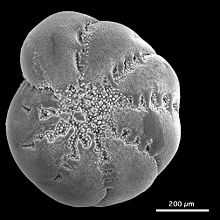Elphidium
| Elphidium Temporal range: Early Eocene to Holocene | |
|---|---|
| Scientific classification | |
| Domain: | Eukaryota |
| Kingdom: | Rhizaria |
| Superphylum: | Retaria |
| Phylum: | Foraminifera |
| Order: | Rotaliida |
| Superfamily: | Rotaliacea |
| Family: | Elphidiidae |
| Genus: | Elphidium de Montfort, 1808 |
| Species | |
|
?E. aculeatum
| |

Elphidium is a genus of foraminiferan protozoa, one of the more common genera found near coasts. Like other forams, fossils from different species are used to date rocks.
Description
Elphidium is one of the more beautiful foraminiferans and once seen easy to recognize. The test (shell) is lenticular, composed of finely perforate, bilamellar, optically radial, or less commonly granular, calcite, planispirally enrolled. Coiling is involute or partially evolute, with seven to twenty chambers in the final whorl and may have umbilical plug on each side. In some species the rim is sharp, keel-like, in others more rounded. The most diagnostic feature, perhaps, are the retral processes (small backward extensions of the chamber walls) that cross the sutures; giving some the appearance of tiny rolled up glass baskets .
Life cycle
Elphidium shows dimorphism with alternating generations. The complete cycle for Elphidium crispum takes two years in the shallower marine regions, although it may be delayed at deeper stations. Asexual reproduction reaches a peak in spring of first year. Sexual reproduction begins early in the second spring as temperatures begin to rise. The gametes conjugate outside in open sea to produce zygotes and the B form then develops and matures during the second summer.
References
- Alfred R. Loeblich Jr and Helen Tappan, 1964. Sarcodina Chiefly "Thecamoebians" and Foraminiferida; Treatise on Invertebrate Paleontology, Part C Protista 2. Geological Society of America and University of Kansas Press.
- _____ 1988. Forminiferal Genera and their Classification. E-book
- For illustrations see: Elphidium, World Modern Foraminifera Database